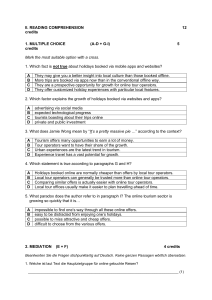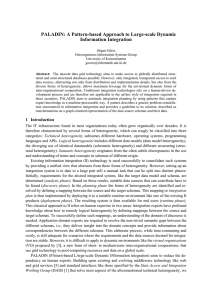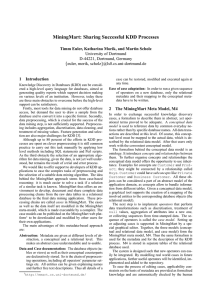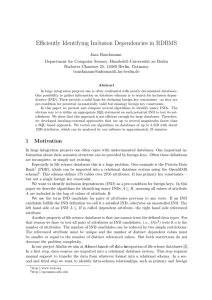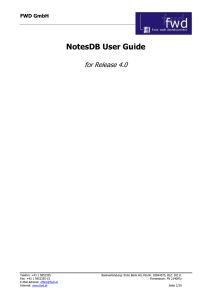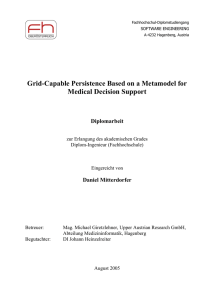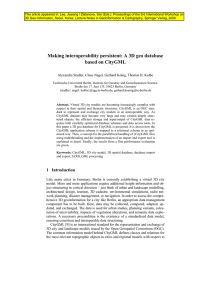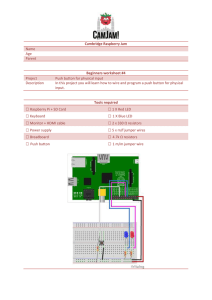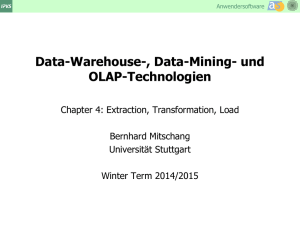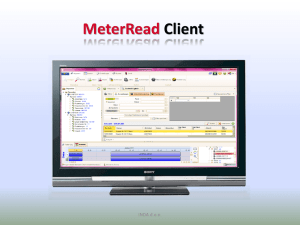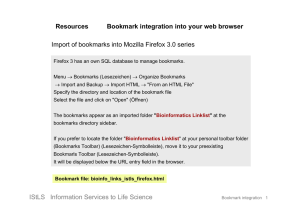Transformation of Models in(to) a Generic Metamodel
Werbung
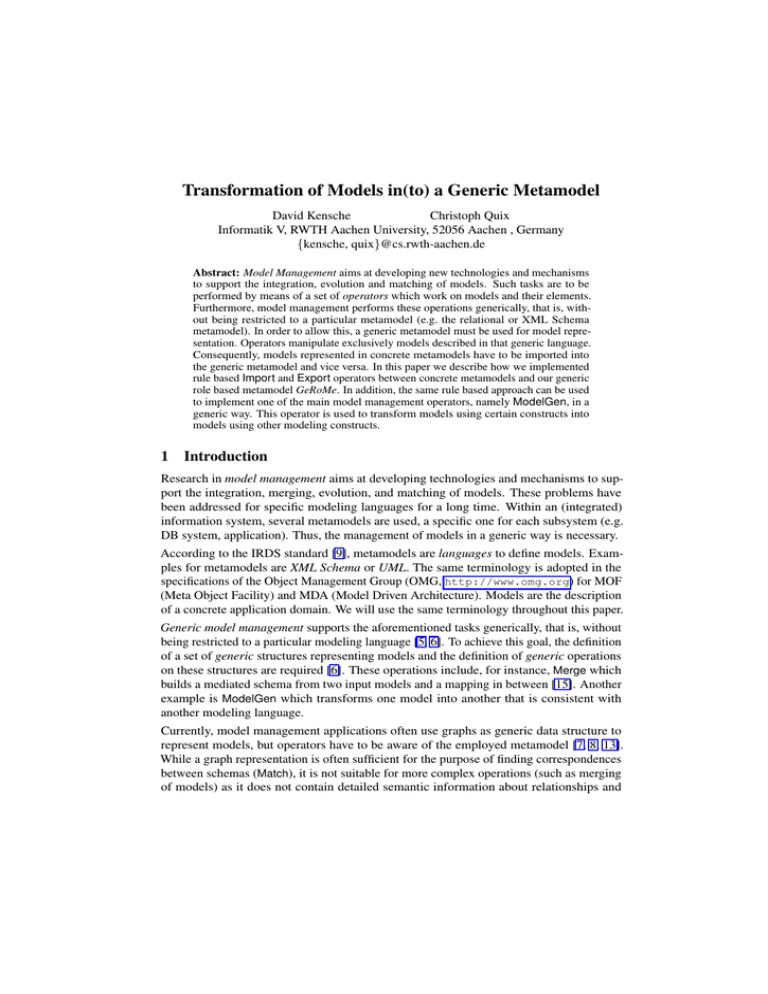
Transformation of Models in(to) a Generic Metamodel
David Kensche
Christoph Quix
Informatik V, RWTH Aachen University, 52056 Aachen , Germany
{kensche, quix}@cs.rwth-aachen.de
Abstract: Model Management aims at developing new technologies and mechanisms
to support the integration, evolution and matching of models. Such tasks are to be
performed by means of a set of operators which work on models and their elements.
Furthermore, model management performs these operations generically, that is, without being restricted to a particular metamodel (e.g. the relational or XML Schema
metamodel). In order to allow this, a generic metamodel must be used for model representation. Operators manipulate exclusively models described in that generic language.
Consequently, models represented in concrete metamodels have to be imported into
the generic metamodel and vice versa. In this paper we describe how we implemented
rule based Import and Export operators between concrete metamodels and our generic
role based metamodel GeRoMe. In addition, the same rule based approach can be used
to implement one of the main model management operators, namely ModelGen, in a
generic way. This operator is used to transform models using certain constructs into
models using other modeling constructs.
1
Introduction
Research in model management aims at developing technologies and mechanisms to support the integration, merging, evolution, and matching of models. These problems have
been addressed for specific modeling languages for a long time. Within an (integrated)
information system, several metamodels are used, a specific one for each subsystem (e.g.
DB system, application). Thus, the management of models in a generic way is necessary.
According to the IRDS standard [9], metamodels are languages to define models. Examples for metamodels are XML Schema or UML. The same terminology is adopted in the
specifications of the Object Management Group (OMG, http://www.omg.org) for MOF
(Meta Object Facility) and MDA (Model Driven Architecture). Models are the description
of a concrete application domain. We will use the same terminology throughout this paper.
Generic model management supports the aforementioned tasks generically, that is, without
being restricted to a particular modeling language [5, 6]. To achieve this goal, the definition
of a set of generic structures representing models and the definition of generic operations
on these structures are required [6]. These operations include, for instance, Merge which
builds a mediated schema from two input models and a mapping in between [15]. Another
example is ModelGen which transforms one model into another that is consistent with
another modeling language.
Currently, model management applications often use graphs as generic data structure to
represent models, but operators have to be aware of the employed metamodel [7, 8, 13].
While a graph representation is often sufficient for the purpose of finding correspondences
between schemas (Match), it is not suitable for more complex operations (such as merging
of models) as it does not contain detailed semantic information about relationships and
constraints. For example, in [14] a generic (but yet simple) metamodel is used that distinguishes between different types of associations in order to merge two models. Since we
believe that simple graph based representations are not expressive enough for an integrated
model management system that supports manipulation of models in general, we proposed
the role based metamodel GeRoMe as a solution of this challenge [12].
In this paper we describe how we implemented Import and Export operators that transform
schemas represented in concrete metamodels, such as the relational model, XML Schema,
or OWL (Web Ontology Language), into equivalent models represented in our generic
metamodel. Furthermore, we will apply the same approach to implement rule based set-ata-time ModelGen operators which transform models between different modeling languages.
Finally, we describe the additional requirements of these translation operators.
The rest of the paper is structured as follows. In section 1.1 we briefly describe our role based
approach of generic metamodeling. Section 1.2 summarizes related work on translation
operators. In section 2 we dwell on the challenges and implementation requirements of
Import and Export operators whereas section 3 then gives details on our implementation
of the aforementioned requirements. Section 4 compares the requirements of Import and
Export operators to those of metamodel independent ModelGen operators. The last section
summarizes our lessons learned from this work.
1.1
Our Metamodel: GeRoMe
Our Generic Role based Metamodel GeRoMe (phonetic transcription: dZer@Um) [12] employs the role based modeling approach. In role based modeling, an object is regarded as
playing roles in collaborations with other objects. Applied to generic metadata modeling
this approach allows to decorate a model element with a combination of multiple predefined
aspects, thereby describing the element’s properties as accurately as possible while using
only metaclasses and roles from a relatively small set. In such a generic metamodel, the different features of a model element (e.g. it is not only an Aggregate but also an Association)
are only different views on the same element. During model transformations an element
may gain or lose roles, thereby adding and revoking features.
Figure 1 shows part of the representation of an EER model for the airport domain and the
equivalent representation in our generic metamodel GeRoMe. It contains a relationship
type with an attribute and two entity types, the attributes of which we omitted from the
PlaneType
Flies
Hours
1,n
pilot
Hours
Pilot
Att
Ag
Flies
OS
NS As
PlaneType OS
Ag
NS
OE
pilot
OE
OS
min,max: (1, n)
Figure 1: A small EER model and the GeRoMe representation of the same model
Pilot
NS
Ag
example. In GeRoMe each of the types, attributes and relationship ends is represented
by an individual model element node (shown as grey rectangles). Every GeRoMe model
element plays some roles depending on the features of the source model element that it
represents. The Hours element plays an Attribute role (Att) as it represents an attribute, the
entity types play ObjectSet roles (OS) since their instances have object identity (as opposed
to the instances of a relational table) and Aggregate roles (Ag) as they are aggregates of
attributes (not shown). The Namespace roles (NS) are played because the types define their
attributes. The Flies element also plays the role of an Association which connects to two
ObjectAssociationEnds (OE) (pilot and an anonymous one). It must be emphasized that this
representation is not to be used by end users. Instead, it is employed internally by model
management applications, with the goal to provide more information to operators than the
usual graph based model.
1.2
Related Work
Whereas transformation of models between different modeling languages is a frequent task,
it has up to now mainly been adressed in specialized settings which map from one particular
metamodel to another fixed metamodel. The problem of generic model transformation
has recently been adressed in [16] where models are represented as simple graphs and
transformations are given as productions in the reserved graph grammar RGG.
Another approach to generic model representation has been introduced in [3], expressed
in a relational model dictionary [1], and was recently used for the generic ModelGen
implementation MIDST [2]. This approach differs from our representation in that it describes
a class of model elements as a pattern built up from a set of components such as an EER
relationship type which is composed of at least two participators and any number of
attributes. A model element belongs to a class of modeling constructs if it matches the
given pattern. All metamodels are mapped to a very small set of modeling constructs. In
contrast, we regard the differences in the semantics of modeling constructs in different
metamodels as subtle but important. For example, modeling sets with object identity and
sets without object identity in the same way results in hiding this knowledge in code of
the model management system whereas it should be part of the generic representation.
In our representation we describe a model element by the set of roles it plays and their
relationships to other elements. A small difference between two constructs can be modeled
by adding a role to an element and thereby adding a new feature to the element.
The schema translations described in [2] are similar to ours in that they are also based on
rules. One of the main differences to our approach is that MIDST specifies all facts about
one model element in one term, whereas our terms about model elements use reification,
the benefits of which we will explain in section 3.
QVT (Queries, Views, Transformations, http://www.omg.org/docs/ad/02-04-10.
pdf) is a standard for model transformation in the context of MDA (model driven architecture). It comprises declarative and imperative languages. However, there does not yet exist
a complete implementation of this standard.
Another important implementation of model transformation which allows declarative and
procedural specification of transformations is the Atlas Transformation Language (ATL)
[10, 11]. Like QVT, ATL deals with transformation in the context of MDA, and employs
a hybrid transformation approach, i.e. the transformation is specified using declarative
rules and imperative code. Rules and helper functions can be defined using a version of
OCL (object constraint language) that has been extended to allow the handling of multiple
metamodels. In QVT and ATL the rules that transform models are always defined on
the metaclasses of the respective metamodels. That is, they are aware of the respective
modeling languages. On the other hand, our goal is to allow generic model transformations
that are indifferent to the employed metamodel. Therefore, the QVT and ATL approach is
not appropriate for us.
2
Challenges and Requirements
A generic metamodel allows polymorphic usage of operators. However, in this setting if
operators apply to models represented in the generic metamodel, models represented in
native metamodels must be transformed into the generic metamodel and vice versa. The
implementation of Import and Export operators can also be used as a validation of GeRoMe
by proving that the modeling constructs from various metamodels can be imported and
exported without loss of information. While implementing the mapping rules for the import
and export operators, we have to assert that structures or constraints are uniquely imported
into our metamodel and, vice versa, that GeRoMe represents these features non-ambigously,
so that they can be exported again into the native format.
However, a formal proof of the correctness of such transformations is not possible. In [2]
the authors already argued for their system that a formal proof of losslessness of translations
to a generic metamodel is hopeless as even a test for losslessness of translations between
two native metamodels is undecidable [4]. However, we tried to ease the formulation of
such a mapping by implementing import and export in a way which allows the developer to
concentrate on defining the mapping rules in a declarative way rather than distributing the
mapping over a set of Java classes.
This section lists the requirements which this import and export functionality must meet.
1. Human-readable correspondences. Specifications of correspondences of concrete
metamodel elements with their respective GeRoMe representations should be easily human
readable in order to increase maintainability and extensibility.
2. Set-at-a-time translation. Usually, the transformation of models has to consider several
model elements at a time. Therefore, Import and Export operators should work on a setat-a-time basis rather than using complex navigational code which can only address one
object at a time.
3. Mutually consistent Import and Export. Both translation operators for one native
metamodel must rely on the same specification of inter-metamodel correspondences in order
to prevent inconsistencies. Thus, correspondences specify equivalence of representations.
4. Define correspondences in a declarative way. Knowledge about correspondences of
modeling constructs must not be hidden in imperative code of the system. Otherwise,
the last requirement would be violated since different implementations had to be used for
import and export. Declarative translation rules are more transparent than imperative code.
5. Incremental development of translations shall be possible. Because relationships
between the modeling constructs may be very complex, it must be possible to formalize
them independently from each other without causing undesirable side effects. Thus, we
have to ease an incremental implementation of translation operators.
6. Generation of elements shall be possible. Translation of models between metamodels
requires new model elements to be generated. For example, as stated in [12] XML Schema
elements are modeled in GeRoMe as associations with two association ends. In XML
Schema, the association ends are given implicitly by the nesting structure of the element
declarations. Thus, during the import into GeRoMe new model elements have to be generated. Hence, it must be possible to generate identifiers for these new model elements. They
must be reproducible as the same generated model elements may occur in the consequents
of multiple rules.
3
Implementation
Applications dealing with models require support for model management in several ways.
Our goal is to provide a library for the management of models (including the definition
of several operators) that can be reused. Our implementation of a model management
platform contains an object model of our metamodel and a set of model management
operators working on models represented in GeRoMe. Operators are not aware of the
original metamodel, i.e. their implementations use only roles and structures in GeRoMe.
The requirements given in the preceding section strongly suggest to use a rule based
approach for the implementation of Import and Export operators in which the antecedent of
a rule selects the set of model elements and the consequent describes the resulting elements
in the target metamodel. Since both, the Import and the Export operator for a modeling
language, must rely on the same set of rules, our rules must be given as statements of
equivalence between representations. This makes them applicable in both directions.
The equivalence rules are evaluated by a meta-program implemented in Prolog, which is
able to handle rules with multiple predicates on both sides. Depending on whether the
rules are used for import or export, the rule set is evaluated from left to right or the other
way around. Our implementation uses SWI Prolog (http://www.swi-prolog.org)
as underlying Prolog engine. In addition, the JPL package (Java Prolog Library) is used
as a bridge between Java and Prolog. We currently use the Import and Export operators
in an editor component for models represented in GeRoMe, in a matching system for
schemas represented in different modeling languages, and in an implementation of the
Merge operator that produces an integrated schema from two input schemas and a mapping
in between.
Our logical notation of models uses reification to specify terms about GeRoMe model
elements. The fact modelElement(ID) states that an object ID is a model element.
Role objects are not explicitly represented; they are denoted as terms which have the name
of their role class as functor and all objects on which they depend as arguments. For
example, attribute(ID) states that the model element ID plays the Attribute role. The
same term can be used to identify the role object. The attr relationship is also reified: a term
like attrName(o, v) denotes that the object o has the value v for the attribute called
attrName. For example, max(attribute(ID), 1) specifies that the max-attribute
of the role object defined above is 1.
3.1
Import and Export
Fig. 2 shows an example. The rules are expressed in standard Prolog syntax, i.e. labels
starting with an upper-case letter denote variables. The evaluation of the rules by Prolog
and their definition as equivalence rules satisfy requirements 2 (set-at-a-time translation)
and 3 (mutually consistent Import and Export).
The example defines the import of a column of a SQL table into a GeRoMe model. The
column with the identifier ID belongs to a table and has a name and a type. In GeRoMe,
we will create a model element with the same ID. The second statement defines the
relationship between the namespace role of the table and the newly created model element.
The following statements define that the element is visible and has a name. Then, we have
to specify that the new model element plays also the Attribute role, and link this role to the
Aggregate role of the model element representing the table. Finally, the type of the attribute
is defined by linking it to the Domain role of the type, and the maximum cardinality of the
attribute is set to 1.
With reification each model element in a GeRoMe model is described by a set of facts
stating that the model element exists, which roles the element plays and which attribute
values its roles have. Besides improving the readability (requirement 1) reificiation has
more advantages. Often the translation of a model element only differs slightly when one of
its properties differs. For instance, a SQL column will always be represented as a GeRoMe
attribute. But if it is nullable, then the attribute will have a minimum cardinality of 0,
otherwise it will be 1. If we would not use reification, but had used one large term of the
form sql column(ID,TableID,Name,Type,Nullable) we had to specify two
almost identical rules for the translation between columns and attributes. These two rules
would differ only in the two cases of Nullable and in the resulting values for the max
attribute. By using reification, we can split the two large identical rules into three small
rules, two of which deal with the cases of cardinality, and the other translates the remaining
properties of the model element. Thus, reification allows reduction of code copy which is
in general a good practice.
Another important term in this rule is :translateType(Type, GeRoMeType). It
translates SQL domains into their GeRoMe representations and vice versa. A variable must
be used for the attribute type in the rule, otherwise the rule has to be copied for each possible
type. The translateType predicate is a mapping of types between the two metamodels.
This translation is necessary in both directions (import and export), and consequently, the
same term must be included on both sides of the rule.
The leading colon is a syntactic convention which indicates that this term should be handled
like a normal Prolog predicate and is ignored if it occurs in the consequent of a rule.
Sometimes it is necessary to check more complex conditions before an element can be
sql_column(ID),
sql_column_table(ID, TableID),
sql_column_name(ID, Name),
sql_column_type(ID, Type)
:translateType(Type, GeRoMeType) <=>
modelElement(ID),
owned(namespace(TableID), ID),
visible(ID),
name(visible(ID), Name),
attribute(ID),
property(aggregate(TableID), attribute(ID)),
type(attribute(ID), domain(GeRoMeType)),
max(attribute(ID), 1),
:translateType(Type, GeRoMeType).
sql_column_nullable(ID, true) <=>
min(attribute(ID), 0).
sql_column_nullable(ID, false) <=>
min(attribute(ID), 1).
Figure 2: Example rules for the Import/Export of SQL models
imported which can be implemented by custom predicates.
Some predicates in fig. 2 (e.g. owned(..)) have terms as arguments. As described above,
these terms represent the role objects. From a logical perspective, we can interpret them as
Skolem functions, which have been introduced on the right hand side to replace existentially
quantified variables. As the goal is to construct objects using the GeRoMe-API, these
functions must return meaningful objects. Therefore, when we create the GeRoMe objects
from a set of facts, these functions will return the corresponding role objects of the given
model elements, e.g. attribute(ID) returns the Attribute role of the model element ID.
In doing so, we make sure that the same objects are used if they are referenced in different
rules; for example, the attribute role of ID is referenced in all rules of fig. 2.
A built-in skolem function is generateId(..) that can be used to generate a unique
identifier for a new model element from the arguments. If the generated identifier is needed
in more than one rule to enrich it with more features, we can reproduce the identifier from
the arguments. In doing so, requirement 6 is satisfied. Additionally, generateId sorts
the identifier components lexically to ensure that the generated identifier does not depend
on the order of the input terms.
The same rules are used for importing and exporting models. Depending on the target
metamodel, a ruleset is activated and evaluated based on a set of facts representing the
GeRoMe model. The given rule translates all model elements satisfying the right hand side
of the rule to SQL columns.
Furthermore, our Export operators act credulously in that they do not check any constraints
on the GeRoMe model which must be satisfied for it to be able to be exported to the target
modeling language. Thus, prior to exporting a model to a native metamodel, problematic constructs (i.e. constructs which are not allowed in the target metamodel) must be
transformed by ModelGen operators.
It must be emphasized that an import to and an export from GeRoMe might result in a
model different from the original model, as there are redundant ways to represent the same
modeling construct in specific metamodels. For example, consider an OWL object property
described as being functional; this could also be modeled by an inverseFunctional statement
of the inverse property. In the import/export rules, such ambiguity will be resolved by using
negation, e.g. the property will be defined as functional only if there is no (visible) inverse
property that could be declared as inverseFunctional or vice versa.
3.2
Using Reflection
We do not plan to develop only a system for model transformation but a toolbox for model
management in general. Thus, although we deem ModelGen to be best developed declaratively, other model management operators such as Match are better implemented in an object
oriented language. Therefore, we must be able to traverse from declarative representations
of models to object oriented representations. We used reflection to implement this transition
for both, import and export. When importing, an AbstractImport operator translates
the generated facts about the GeRoMe model to calls to the API which create an object
model of the schema. When exporting, the Prolog facts about a GeRoMe model are created
from the object model using reflection as well.
When a new native metamodel is to be supported we only have to implement two classes.
One is, for instance, ImportXSD that traverses the model to be imported (e.g. using
an XML Schema API), and generates facts in the representation to be used by the rules.
Although this is not a strong requirement, the elements in the native modeling language
should be described using reification because this will simplify the definition of the rules,
as discussed in the examples above.
The Export operator works analogously. It uses the same rule file as the import of models,
but interprets the rules from right to left. The ExportXSD class implements a hook method
that creates the native model from the derived facts, again, using an appropriate API.
Due to the role and rule based approach and the generic implementation of the necessary
Java classes the effort of supporting a new metamodel is minimized. Requirement 4 (define
correspondences declaratively) is satisfied as the two classes to be implemented merely
produce (or read) a special syntactic representation of the model and do not perform any
sophisticated processing of the models. Since correspondences are not hidden in imperative
code but given as a set of equivalence rules, the developer can concentrate on the logical
correspondences and does not have to deal with implementation details. For example,
import and export of SQL requires about 250 lines of Java code for each operator, and about
200 lines of code for the Prolog rules. The relationships between the modeling constructs
could be expressed in less than 20 equivalence rules. Due to our approach the developer
does not need to take all modeling constructs into account in the first place. Facts that are
not used in rules are simply ignored. Since reification is used, the developer need not even
consider all features of a single model element but can incrementally add detail to the rules.
Thus, requirement 5 (incremental development of translations) is met. On the other hand
if the role and rule based approach had not been used, a developer could easily get lost in
lengthy translation classes.
4
Generic ModelGen Requirements
In model management, transformations of models between different metamodels, such
as the classical EER to relational mapping or the derivation of a relational model from
an XML Schema or vice versa are performed by so called ModelGen operators. These
operators mainly focus on transforming modeling constructs allowed in the source schema
but disallowed in the target schema to modeling constructs allowed in the target schema [2].
Similarly to Import and Export operators, ModelGen performs set-at-a-time translations
on the model elements in a schema based on some precondition. Therefore, we aim at
implementing these operators based on the same approach that we used for Import and
Export operators. There are also commonalities in the implementation requirements of
these operators:
• The semantics of ModelGen operators should not be hidden in procedural code
but should be implemented in a way which improves readability, maintainability,
extensibility, and incremental development.
• The effort of developing new ModelGen operators should be minimized. Using
the rule based approach, the implementation effort is restricted to specifying the
necessary translation rules. The existing classes for generating facts about models
and creating objects from facts will only have to be adapted once to reflect possible
extensions of our rules.
• ModelGen operators require new model elements to be generated. Consequently, it
must be possible to generate identifiers for these new elements. Thus, we can use the
same solution as for the import/export operators.
However, there are also new requirements for ModelGen:
1. Allow user interaction. Whereas Import and Export operators must and can be fully
automated, ModelGen often requires decisions to be made where the required knowledge
is not encoded in the input model. For instance, removing IsA relationships from an EER
model requires knowledge about expected queries to the target model. Consequently, an
appropriate hook for user interaction must be included into the rule interpreter.
2. Unidirectional rules. As ModelGen operators often delete model elements or role
objects disallowed in the target model, they almost always reduce the information encoded
in the model. Thus, their rules will usually be only applicable in one direction, unless the
deleted information is re-entered by the user.
3. Traceability. Traceability of actions performed by ModelGen is required, such that a
user can recognize which elements have been generated, deleted, or changed. Otherwise, it
will be impossible to verify the result.
4. Mapping generation. During model transformation a mapping from the original model
to the resulting model should be iteratively developed. That is, it must be updated each
time a modeling construct is transformed. This also implies that after transformation the
original model still exists and the resulting model is a new version of the original model.
We believe that this can be reflected by introducing time stamps or state counters to the
[ modelElement(AS), modelElement(SourceAE), modelElement(TargetAE) ]
[ association(AS),
objectAssociationEnd(SourceAE),
objectAssociationEnd(TargetAE),
property(association(AS), objectAssociationEnd(SourceAE)),
property(association(AS), objectAssociationEnd(TargetAE)),
participator(objectAssociationEnd(SourceAE), SourceType),
participator(objectAssociationEnd(TargetAE), TargetType),
max(objectAssociationEnd(SourceAE), 1),
max(objectAssociationEnd(TargetAE), N), N > 1,
:arity(association(AS), 2),
name(visible(KeyAtt), KeyAttName),
property(aggregate(TargetType), KeyAtt),
type(attribute(KeyAtt), Domain),
component(injective(ID), attribute(KeyAtt)),
identified(identifier(injective(ID)), aggregate(TargetType)),
:generateID(referenceTo(KeyAtt), RefAtt),
:generateID(fk(TargetAE), FK)
] => [
modelElement(RefAtt), attribute(RefAtt),
type(attribute(RefAtt), Domain),
component(FK, reference(attribute(RefAtt))),
aggregate(SourceType), property(aggregate(SourceType),
attribute(RefAtt)), reference(attribute(RefAtt)),
referenced(attribute(RefAtt), attribute(KeyAtt))
visible(RefAtt), name(visible(RefAtt), KeyAttName) ]
Figure 3: Example rule transforming object references to attribute references
model elements which are increased by application of the rules. Such counters will also
ease tracing ModelGen as all intermediate states are preserved throughout subsequent
transformation steps. One can collect all information about performed steps by querying
Prolog for subsequent states.
5. Reusability. There are some transformation tasks which are common for several model
transformation scenarios, such as transforming an EER model to a relational schema or
transforming a UML model to a relational schema. In both cases, IsA relationships and
complex attributes have to be transformed into corresponding elements in the relational
schema. Thus, such “simple” transformations should be implemented as elementary
ModelGen operators which can be reused in the definition of a complex ModelGen operator
transforming a complete model.
Despite these differences we believe that our rule based implementation must only be
slightly extended to meet the requirements of ModelGen.
Figure 3 shows an example of how a transformation rule could look like that satisfies
some of the requirements. The example depicts a rule for transforming object references
to simple typed references (i.e. associations to foreign keys). It could be used for the
EER-to-relational mapping but also for transforming XML schema elements to referential
constraints which would satisfy the reusability requirement.
The rule is partitioned into three parts. The first two parts are the antecedent of the rule,
whereas the last part is the consequent. The terms in the rule do not contain state counters
that distinct the different versions of the models. It is not necessary to include these counters
explicitly as this can be easily handled by the interpreter just by incrementing the counter
of the elements in the consequent.
We assume that each transformation will usually transform only a small number of model
elements, whereas the majority of elements can be copied by default from one version of
the model to the next version. Therefore, we partition the antacedent into two parts. The
first part contains the model elements that are transformed. Conditions on other elements,
such as the SourceType which are to be copied to the target model, must occur only in
the second part. Any element that occurs in the first part of a rule will not be copied to the
target model. This works recursively; in the example, the model element AS representing
the association and its association ends (SourceAE and TargetAE) and all of their roles
will not be copied. Of course, references to any of the roles of deleted elements must also
not be copied to the target model. The second part in the example specifies the conditions
for the association: in this case, we are considering binary (arity of 2) one-to-many (the
max cardinality of the association ends is 1 and N) associations. The remaining predicates
in the second part retrieve the key attribute of the target aggregate. The two generateID
predicates generate the identifiers for the model elements representing the reference (i.e.
the foreign key constraint) and the attribute which has to be added to the source type. The
corresponding model elements and their roles which should be present in the target model
are then specified in the third part.
5
Lessons Learned and Outlook
The implementation of Import and Export operators in model management underlies certain
requirements, such as mutally consistent import and export, declarative definition, and
maintainability. A role and rule based approach is a perfect fit for realizing these requirements among others. Furthermore, the usage of reification drastically reduces the lines of
code of translation rules by avoiding copying of large portions of translation rules.
Using a rule-based approach for specifying the Import and Export operators has the advantage that the semantics of these operators can be specified in a declarative way and is
not hidden in the code of a complex transformation function. In addition, our approach
is fully generic; it uses reflection and annotations in Java to create objects or to generate
facts from an existing GeRoMe model. Therefore, the code required to support another
metamodel is limited to the generation of the metamodel-specific facts and the specification
of the equivalence rules. This reduces the effort for the implementation of the operators
significantly.
In the near future we will extend our implementation in order to realize rule based ModelGen
operators. These operators will perform metamodel independent transformations of models
represented in our generic metamodel. Certain enhancements are necessary for this task,
such as the introduction of state counters, traceability of actions, and hooks for user
interaction. However, the current implementation of Import and Export seems to be an
adequate basis for an implementation of rule based set-at-a-time ModelGen operators.
References
[1] P. Atzeni, P. Cappellari, and P. A. Bernstein. A multilevel dictionary for model management. In
Proc. Conf. Conceptual Modeling (ER), volume 3716 of LNCS, pages 160–175. Springer, 2005.
[2] P. Atzeni, P. Cappellari, and P. A. Bernstein. Model-independent schema and data translation.
In EDBT, volume 3896 of LNCS, pages 368–385. Springer, 2006.
[3] P. Atzeni and R. Torlone. Management of multiple models in an extensible database design tool.
In Proc. EDBT, volume 1057 of LNCS, pages 79–95. Springer, 1996.
[4] D. Barbosa, J. Freire, and A. O. Mendelzon. Information preservation in XML-to-relational
mappings. In Proc. XSym 2004, volume 3186 of LNCS, pages 66–81. Springer, August 2004.
[5] P. A. Bernstein. Applying model management to classical meta data problems. In Proc.
CIDR’03, Asilomar, CA, 2003.
[6] P. A. Bernstein, A. Y. Halevy, and R. Pottinger. A vision for management of complex models.
SIGMOD Record, 29(4):55–63, 2000.
[7] P. A. Bernstein, S. Melnik, M. Petropoulos, and C. Quix. Industrial-strength schema matching.
SIGMOD Record, 33(4):38–43, 2004.
[8] M. A. Hernández, R. J. Miller, and L. M. Haas. Clio: A semi-automatic tool for schema
mapping. In Proc. ACM SIGMOD’01, page 607, Santa Barbara, CA, 2001. ACM Press.
[9] ISO/IEC. Information technology – information resource dictionary system (IRDS) framework.
International Standard ISO/IEC 10027:1990, DIN Deutsches Institut für Normung, e.V., 1990.
[10] F. Jouault and I. Kurtev. Transforming models with ATL. In MoDELS 2005 Revised Selected
Papers, volume 3844 of LNCS, pages 128–138. Springer, 2005.
[11] F. Jouault and I. Kurtev. On the architectural alignment of ATL and QVT. In SAC ’06:
Proceedings of the 2006 ACM symposium on Applied computing, pages 1188–1195. ACM Press,
2006.
[12] D. Kensche, C. Quix, M. A. Chatti, and M. Jarke. GeRoMe: A generic role based metamodel
for model management. Journal on Data Semantics, VIII:82–117, 2007.
[13] S. Melnik, E. Rahm, and P. A. Bernstein. Rondo: A programming platform for generic model
management. In Proc. SIGMOD, pages 193–204. ACM, 2003.
[14] R. Pottinger and P. A. Bernstein. Merging models based on given correspondences. In Proc.
VLDB, pages 826–873. Morgan Kaufmann, 2003.
[15] C. Quix, D. Kensche, and X. Li. Generic schema merging. In Proc. 19th Intl. Conference on
Advanced Information Systems Engineering (CAiSE’07), Trondheim, Norway, 2007. to appear.
[16] G.-L. Song, K. Zhang, and J. Kong. Model management through graph transformation. In
VL/HCC, pages 75–82. IEEE Computer Society, 2004.
